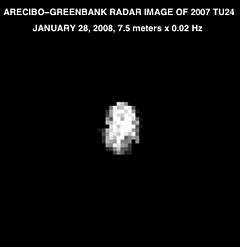2007 TU24
|
Radar image of 2007 TU24. Courtesy NASA/JPL-Caltech | |||||||||
| Discovery | |||||||||
|---|---|---|---|---|---|---|---|---|---|
| Discovered by | Catalina Sky Survey | ||||||||
| Discovery date | October 11, 2007 | ||||||||
| Designations | |||||||||
| Apollo, NEO, PHA[1] | |||||||||
| Orbital characteristics[2] | |||||||||
| Epoch 13 January 2016 (JD 2457400.5) | |||||||||
| Uncertainty parameter 0 | |||||||||
| Observation arc | 1093 days (2.99 yr) | ||||||||
| Aphelion | 3.1343 AU (468.88 Gm) | ||||||||
| Perihelion | 0.95153 AU (142.347 Gm) | ||||||||
| 2.0429 AU (305.61 Gm) | |||||||||
| Eccentricity | 0.53423 | ||||||||
| 2.92 yr (1066.5 d) | |||||||||
| 267.95° | |||||||||
| 0° 20m 15.144s /day | |||||||||
| Inclination | 5.6232° | ||||||||
| 127.041° | |||||||||
| 334.254° | |||||||||
| Earth MOID | 0.000483062 AU (72,265.0 km) | ||||||||
| Jupiter MOID | 2.06887 AU (309.499 Gm) | ||||||||
| Physical characteristics | |||||||||
| Dimensions | ~250 meters[3] | ||||||||
| Mass | < 2.4×1010 kg[4] | ||||||||
Mean density | unknown | ||||||||
Equatorial escape velocity | < 0.58 km/h[4] | ||||||||
| 26 h (1.1 d)[2] | |||||||||
| 0.24 | |||||||||
| |||||||||
| 20.2,[1] 20.3[2] | |||||||||
|
| |||||||||
2007 TU24 is an Apollo near-Earth asteroid that was discovered by the Catalina Sky Survey in Arizona on October 11, 2007. Imaging radar has estimated that it is 250 meters (820 ft) in diameter.[3] The asteroid passed 554,209 kilometer (344,370 mile or 1.4-lunar distance)[5] from Earth on January 29, 2008, at 08:33 UTC. (At the time of the passage it was believed the closest for any known potentially hazardous asteroid (PHA) of this size before 2027,[6] but in 2010 2005 YU55 was measured to be 400 meters in diameter.) At closest approach the asteroid had an apparent magnitude of 10.3 and was about 50 times fainter than the naked eye can see. It required about a 3-inch (76 mm) telescope to be seen.[3]
Impact risk assessment
From the date of discovery of asteroid 2007 TU24 on 11 October 2007, a total of 316 observations of it had been made by 31 January 2008, spanning 112 days.[1] Now the asteroid has an observation arc of about 3 years and the trajectory is well defined.[1] It was removed from the Sentry Risk Table on 4 December 2007 at 14:05 UTC.[7]
2008 passage

Goldstone Observatory carried out radar observations on January 23 and January 24, 2008. As of January 24, the orbit of the asteroid was known with such a high precision that scientists were able to calculate close approaches from the year 67 AD to 2141 AD.[8] On January 29, 2008 at 08:33 UTC, 2007 TU24 passed by the earth at a nominal distance of 0.0037043 AU (554,160 km; 344,340 mi) with a relative speed of 9.248 km/s.[2]
Observations from Arecibo Observatory were taken on February 1–4.[3] It is a contact binary asteroid.[9]

Other close approaches
- Asteroid 2004 XP14 was the closest potentially hazardous asteroid, passing Earth by 432,308 km (268,624 mi), 0.00289 AU, or just 1.1 times the Moon's average distance from Earth on July 3, 2006.
- Asteroid 4179 Toutatis (4.5 km diameter) came within 1.5 million km, 0.0104 AU (within 4 lunar distances) of the Earth on September 29, 2004.
- On August 7, 2027, (137108) 1999 AN10 will pass within 388,960 km (0.0026 AU) of the Earth.
- On Friday, April 13, 2029, Apophis will pass the earth within the orbits of the geosynchronous communication satellites.
See also
- List of notable asteroids
- Asteroid deflection strategies
- Asteroid naming conventions
- Radar astronomy
References
- 1 2 3 4 JPL Small-Body Database Browser: 2007TU24
- 1 2 3 4 "JPL Close-Approach Data: (2007 TU24)" (2010-10-08 last obs (arc=2.99 years)). Retrieved 30 March 2016.
- 1 2 3 4 "NASA Scientists Get First Images of Earth Flyby Asteroid". NASA/JPL. 2008-01-25. Archived from the original on 29 January 2008. Retrieved 2008-01-26.
- 1 2 radius of 0.125 km; volume of a sphere * maximum likely density of 3g/cm³ (though it could be a loose rubble pile) yields an improbable mass of 2.45e10 kg and an improbable escape velocity of 0.58 km/h.
- ↑ "Asteroid Zooms by Earth". NASA/JPL. 2008-01-29. Retrieved 2008-01-30.
- ↑ Near-Earth Asteroid 2007 TU24 to Pass Close to Earth on Jan. 29 - Should be Observable with Modest Sized Telescopes
- ↑ NEOs Removed from Impact Risks Tables
- ↑ 2007 TU24planning.html
- ↑ Dr. Lance A. M. Benner (2013-11-18). "Binary and Ternary near-Earth Asteroids detected by radar". NASA/JPL Asteroid Radar Research. Retrieved 2014-03-01.
External links
- Orbital simulation from JPL (Java) / Horizons Ephemeris
- Asteroid to Make Rare Close Flyby of Earth (Catalina Sky Survey Photo)
- Huge asteroid to fly by past earth.Independent Online
- Asteroid 2007 TU24: No Danger to Earth (Phil Plait January 25, 2008)
- NEODys site entry for 2007TU24
- 2007 TU24 at the JPL Small-Body Database

